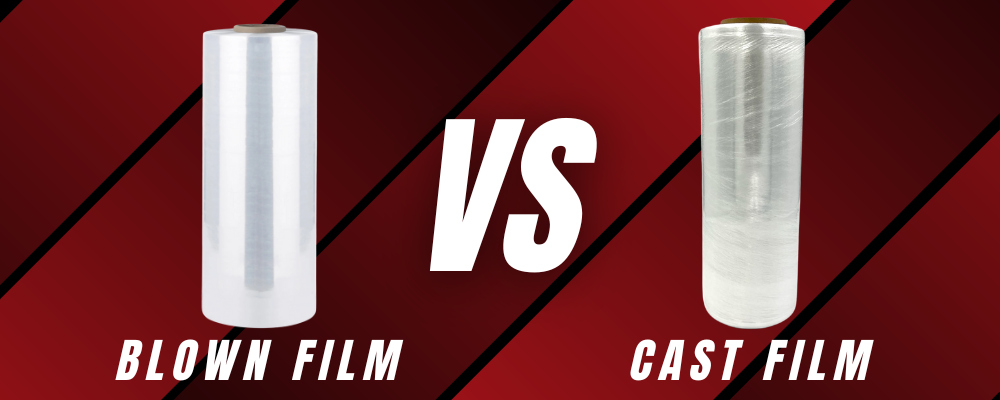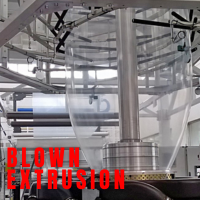By Zach Wahlin | April 22, 2025 | Stretch Film | 0 Comments

Blown vs Cast Stretch Film: Which is Right for Your Business?
Choosing the right stretch film for your application can impact your load stability and overall packaging efficiency. In this blog, you'll discover the key differences between blown and cast stretch films, helping you make an informed decision for your business.
What is the Difference Between Blown Film and Cast Film?
Blown stretch film is created by blowing heated resin into a bubble, which is then cooled. This process results in a film with high puncture resistance and strength, making it ideal for wrapping sharp-edged loads.
On the other hand, cast stretch film is produced by extruding the resin through a flat die and cooling it on a chilled roller. This method creates a film with a high level of cling and clarity, perfect for automated pallet wrapping.
Click here to chat with a stretch film specialist to find the right option for your business.
What is a Cast Stretch Film?
Cast stretch film is known for its excellent clarity and consistent thickness. It is produced using the cast extrusion process, where the film is cooled quickly, resulting in a smooth and glossy finish. This type of film is often used in applications where visual inspection of the load is important.
Advantages of Cast Film
-
High Clarity: Allows for easy inspection of wrapped products.
-
Consistent Thickness: Ensures uniform wrapping and load stability.
-
Quiet Unwinding: Ideal for environments where noise reduction is important.
-
High Cling: Provides excellent load retention.
Disadvantages of Cast Film
-
Lower Puncture Resistance: Not suitable for sharp-edged loads.
-
Less Stretchability: May require more film to achieve the same load stability as blown film.
What is a Blown Stretch Film?
Blown stretch film is produced by blowing molten resin into a bubble, which is then cooled. This process creates a film with superior strength and puncture resistance, making it ideal for heavy or irregularly shaped loads.
Advantages of Blown Film
- High Puncture Resistance: Perfect for wrapping sharp-edged or irregular loads.
- Superior Strength: Provides excellent load stability.
- Better Stretchability: Can be stretched further without breaking.
Disadvantages of Blown Film
- Higher Cost: Generally, more expensive than cast film.
- Lower Clarity: Not as clear as cast film, making visual inspection more difficult.
- Noisy Unwinding: Can be louder during application.
How Stretch Films are Made: Blown vs Cast Extrusion
The manufacturing process for stretch films involves either blown or cast extrusion.
-
Blown extrusion uses a circular die to create a bubble of molten resin, which is then cooled.
-
Cast extrusion, on the other hand, involves extruding the resin through a flat die and cooling it on a chilled roller.
Learn more about stretch film optimization for your packaging process here.
Current Trends in Cast and Blown Film
The stretch film industry is experiencing several trends, particularly in the use of cast and blown films. Here is what is currently happening:
Sustainability Initiatives:
Manufacturers are focusing on eco-friendly materials, using biodegradable and recycled content. They're also developing thinner films that reduce material usage and waste.
Technological Advancements:
Innovations like nano-layer films are enhancing load stability and puncture resistance, while improved resin formulations are boosting clarity and performance.
Shift Towards Cast Film:
The packaging industry is increasingly preferring cast film due to its cost-effectiveness, high clarity, and ease of use. Around 70-80% of the industry worldwide is now using cast film. This shift is driven by the film's unique advantages, such as consistent thickness and quiet unwinding, which are particularly beneficial in automated packaging environments.
environments.
Customization and Specialty Films:
Manufacturers are offering films with enhanced UV resistance, anti-static properties, and higher cling levels to tackle specific packaging challenges and improve efficiency.
By keeping up with these trends, you can make smart decisions to optimize your packaging processes and stay ahead in the game.
Final Thoughts
Choosing between blown and cast stretch film depends on your specific needs. Blow film is the way to go if you require high puncture resistance and strength. However, cast film is a better choice if you need high clarity and consistent thickness.
Feel free to Click here to chat now if you have any questions or need help selecting the right stretch film for your operations.
Contact Us Today to Learn More About The Different Films Rapid Packaging Can Offer or to Ask About An Onsite Stretch Test!

About the Author: Zach Wahlin
Zach Wahlin, a Twin Cities native with a Marketing and Economics degree from the University of Minnesota, is your go-to expert for packaging solutions. With a strong background in software sales and e-commerce distribution, especially in the marine and RV industries, he excels at managing high-volume packaging and shipping needs. His customer-focused approach ensures efficient, tailored solutions for your business. Outside of work, Zach enjoys spending time with his wife and getting ready for their first child. He embraces all Minnesota seasons, whether fishing, hunting, hiking with his dog, or golfing. A die-hard Minnesota sports fan, Zach also enjoys concerts, comedy shows and making the most of summer days on the water. Zach has your packaging needs covered, just like he has most of the best fishing spots in Minnesota. Maybe he'll even share a few with you!
Need Help?
Increase your productivity with entry-level of full-line packaging automation, reduce packaging costs, and increase product protection with a full catalog of packaging supplies.